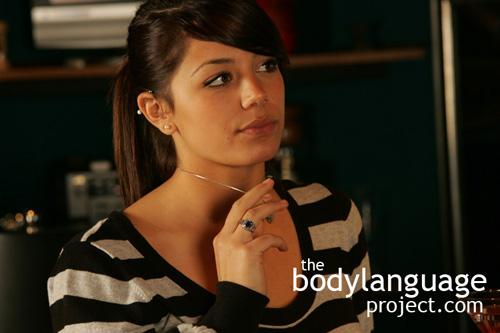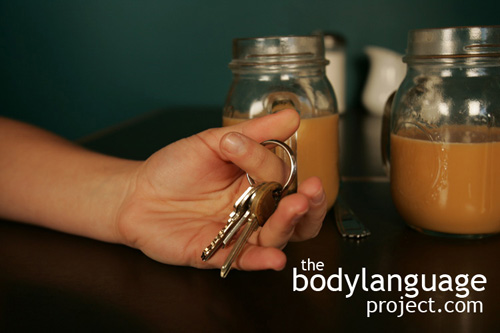Body Language of Suckling
Synonym(s): Mouthing An Object, Chewing On A Pen, Pen Sucking, Sucking On A Pen (or other), Oral Fixation.
Description: When any object including pens or fingers are brought to the lips and chewed or sucked on.
In One Sentence: Suckling indicates a need for self-soothing due to negative feelings.
How To Use it: While suckling can help produce comfort, it is not considered a cue that should be used in full view of others as it is unlikely to produce a desirable impression.
Context: a) General. b) Dating.
Verbal Translation: “I’m in need of an oral fixation to calm my nerves so I’m suckling – on my finger or pen, as I did when I was a baby.”
Variant: See Hand to Mouth, Lip Chewing or Chewing The Lips, Hair Play, Nail Biting.
Cue In Action: a) Debbie was a shy, timid person, she kept her gaze low, easily blushed, and was quiet around strangers. This was especially so when put on the spot or questioned. At her desk, she habitually mouthed pens, paper clips, or chewed on her fingers. a) During the exam, the student mouthed her pen as she suffered through a question she wasn’t familiar with. b) Debbie was thinking about Mark and subconsciously tapped the end of her pen against her lower lip. The pen was a phallic replacement.
Meaning and/or Motivation: The mouth and lips are full of nerve endings which, when stimulated, provides tactile gratification and comfort. However, anytime the fingers go to the mouth such as playing with the side of the mouth or lip, it’s a retrogressive action indicating insecurity. These types of gestures are called “pacifying behaviours” because they are designed to reduce anxiety when someone is exposed to something distressing. Pacifying language tells us that the mind is not at ease, and it is attempting to restore the body’ natural state.
Suckling body language essentially turns us back into babies or at least indicates to others our need for self-soothing due to emotional stress.
Adults that are tense or anxious will play with their mouth or lip. Mouthing a pen, cigarette, hair, and even a piece of gum during emotional distress are substitutes for the mother’s breast. They remind us of early childhood mouthing. Sucking, like plucking, picking or chewing the lips or rubbing them with a finger or thumb are all forms of auto touching. Confident individuals would never consider using these types of security blankets.
Alternatively, an object to the mouth can represent a phallic purpose. Subconscious controls can lead one to bring an object to the mouth during sexual thoughts. The pen for example, can be a substitute for a penis during arousal.
Cue Cluster: Watch for other negative emotional cues such as pinching the skin, scratching, smoothing clothing, eye aversion, head lowered, blushing, trembling, attempt to exit (escape movements), ventral denial, turning the body away, sweating and so forth.
Body Language Category: Amplifier, Auto contact or self touching, Boredom body language, Courtship displays, Displacement behaviour, Embarrassment (nonverbal), Emotional body language, Idiosyncratic body language, Indicators of sexual interest (IOsI), Low confidence body language, Oral displacement activities, Pensive displays, Pseudo-infantile gestures, Pacifying body language, Security blankets, Shy nonberbal, Worry body language.
Resources:
Azrin, N.H. ; Nunn, R.G. ; Frantz-Renshaw, S. Habit reversal treatment of thumbsucking. Behaviour Research and Therapy. 1980. 18(5): 395-399.
Argo, J. J., Dahl, D. W., & Morales, A. C. (2006). Consumer contamination: How consumers react to products touched by others. Journal of Marketing, 70(April), 81–94.
Bakwin, Harry. Thumb- and finger-sucking in children. The Journal of Pediatrics. 1948. 32(1): 99-101.
Cohen, Keith N. ; Clark, James A. Hogan, Robert (editor). Transitional object attachments in early childhood and personality characteristics in later life. Journal of Personality and Social Psychology. 1984. 46(1): 106-111.
Caplovitz Barrett, Karen. The origins of social emotions and self-regulation in toddlerhood: New evidence. Cognition & Emotion. 2005. 19(7): 953-979.
Castles, Duncan L. ; Whiten, Andrew ; Aureli, Filippo. Social anxiety, relationships and self-directed behaviour among wild female olive baboons. Animal Behaviour. 1999. 58(6): 1207-1215.
D’alessio, M. ; Zazzetta, A. Development of Self-Touching Behavior in Childhood. Perceptual and Motor Skills. 1986. 63(1): 243-253.
Dimond, Stuart ; Harries, Rashida. Face touching in monkeys, apes and man: Evolutionary origins and cerebral asymmetry. Neuropsychologia. 1984. 22(2): 227-233.
Erkolahti, R., & Nystro¨m, M. (2009). The prevalence of transitional object use in adolescence: is there a connection between the existence of a transitional object and depressive symptoms? European Child Adolescence Psychiatry, 18, 400–406.
Foster, Laura Gutermuth. Nervous Habits and Stereotyped Behaviors in Preschool Children. Journal of the American Academy of Child & Adolescent Psychiatry. 1998. 37(7): 711-717.
Festjens, Anouk; Sabrina Bruyneel and Siegfried Dewitte. What a Feeling! Touching Sexually Laden Stimuli Makes Women Seek Rewards. Journal of Consumer Psychology. 2013. http://dx.doi.org/10.1016/j.jcps.2013.10.001
http://bodylanguageproject.com/articles/not-sexy-images-sexy-touch-drives-womens-purchases/
Friman, P C ; Mcpherson, K M ; Warzak, W J ; Evans, J. Influence of thumb sucking on peer social acceptance in first-grade children. Pediatrics. 1993. 91(4): 784-6.
Goldberg, Shelly ; Rosenthal, Robert. Self-touching behavior in the job interview: Antecedents and consequences. Journal of Nonverbal Behavior. 1986. 10(1): 65-80.
Garnefski N 2004) Cognitive emotion regulation strategies and depressive symptoms: differences between males and female. Personal Indiv Diff 36: 267–76.
Huflejt-Łukasik M, Czarnota-Bojarska J (2006) Short Communication: Selffocused attention and self-monitoring influence on health and coping with stress. Stress Health 22: 153–59.
Honzik, Marjorie P. ; McKee, John P. The sex difference in thumb-sucking. The Journal of Pediatrics. 1962. 61(5): 726-732.
Juni, Samuel ; Cohen, Phyllis. Partial impulse erogeneity as a function of fixation and object relations. Journal of Sex Research. 1985. 21(3): 275-291.
Kalpidou, Maria. Sensory Processing Relates to Attachment to Childhood Comfort Objects of College Students. Early Child Development and Care. 2012. 182(12): 1563-1574.
Kochanska, G., Coy, K. C., & Murray, K. T. (2001). The development of self-regulation in the first four years of life. Child Development, 72, 1091–1111.
Katza, Carmit; Irit Hershkowitz; Lindsay C. Malloya; Michael E. Lamba; Armita Atabakia and Sabine Spindlera. Non-Verbal Behavior of Children Who Disclose or do not Disclose Child Abuse in Investigative Interviews. Child Abuse & Neglect. 2012. 36: 12-20.
http://bodylanguageproject.com/articles/reading-nonverbal-behaviour-child-abuse-cases-encourage-children-divulge-information-truth-telling
Kirschbaum C, Pirke K-M, Hellhammer DH. 1993. The ‘Trier Social Stress Test’: a tool for investigating psychobiological stress responses in a laboratory setting. Neuropsychobiology 28: 76–81.
Kammers, Marjolein P.M. ; de Vignemont, Frédérique ; Haggard, Patrick. Cooling the Thermal Grill Illusion through Self-Touch. Current Biology. 2010. 20(20): 1819-182.
Lastovicka, J. L., & Sirianni, N. J. (2011). Truly, madly, deeply: Consumers in the throes of material possession love. Journal of Consumer Research, 38(2), 323–341.
Lehman, E.B., Arnold, B.E., & Reeves, S.L. (1995). Attachments to blankets, teddy bears, and other nonsocial objects: A child’s perspective. The Journal of Genetic Psychology, 156(4), 443–459.
Lehman, E.B., Holtz, B.A., & Aikey, K.L. (1995). Temperament and self-soothing behaviour in children: Object attachment, thumbsucking, and pacifier use. Early Education and Development, 6(1), 53–72.
Meier, B. P., Schnall, S., Schwarz, N., & Bargh, J. A. (2012). Embodiment in social psychology. Topics in Cognitive Science, 4(4), 705–716.
Maclaren, Kym. Touching matters: Embodiments of intimacy. Emotion, Space and Society. 2014. 13: 95-102.
Maestripieri D, Schino G, Aureli F, Troisi A. 1992. A modest proposal: displacement activities as an indicator of emotions in primates. Anim Behav 44:967–979.
Mohiyeddini, C., Bauer, S., & Semple, S. (2013a). Displacement behaviour is associated with reduced stress levels among men but not women. PLoS One, 8, e56355.
Mohiyeddini, C., Bauer, S., & Semple, S. (2013b). Public self-consciousness moderates the link between displacement behaviour and experience of stress in women. Stress, 16, 384–392.
Mohiyeddini, C., & Semple, S. (2013). Displacement behaviour regulates the experience of stress in men. Stress, 16, 163–171.
Mahalski, P. (1983). The incidence of attachment objects and oral habits at bedtime in two longitudinal samples of children aged 1.5–7 years. Journal of Child Psychology and
Psychiatry, 24(2), 283–295.
Moore, Monica. Courtship Signaling and Adolescents: Girls Just Wanna Have Fun. Journal of Sex Research. 1995. 32(4): 319-328.
http://bodylanguageproject.com/articles/girls-just-want-to-have-fun-the-origins-of-courtship-cues-in-girls-and-women/
Michel Desmurget; Nathalie Richard; Sylvain Harquel; Pierre Baraduc; Alexandru Szathmari; Carmine Mottolese; and Angela Sirigu. Neural representations of ethologically relevant hand/mouth synergies in the human precentral gyrus. PNAS. 2014. 111 (15).
Mendez, Mario F. ; Mirea, Adrian. Adult head-banging and stereotypic movement disorders. Movement Disorders. 1998. 13(5): 825-828.
Neuroscience: Why babies live hand to mouth. Nature. 2014. 508(7494). p.10.
Navarro, Joe. 2008. What Every BODY is Saying: An Ex-FBI Agent’s Guide to Speed-Reading People. William Morrow Paperbacks.
Nolen-Hoeksema S, Aldao A (2011) Gender and age differences in emotion regulation strategies and their relationship to depressive symptoms. Personal Indiv Diff 51: 704–8.
Peck, J., & Shu, S. B. (2009). The effect of mere touch on perceived ownership. Journal of Consumer Research, 36(Oct), 434–447.
Pless, I. B. ; Cripps, H. A. ; Davies, J. M. C. ; Wadsworth, M. E. J. Chronic physical illness in childhood: psychological and social effects in adolescence and adult life. Developmental Medicine and Child Neurology. 1989. 31(6): 746(10).
Pecora, Giulia ; Addessi, Elsa ; Schino, Gabriele ; Bellagamba, Francesca. Do displacement activities help preschool children to inhibit a forbidden action? Journal of Experimental Child Psychology. 2014. 126: 80-90.
Passman, R.H. (1987). Attachments to inanimate objects: Are children who have security blankets insecure? Journal of Consulting and Clinical Psychology, 55(6), 825–830.
Schino G, Perretta G, Taglioni AM, Monaco V, Troisi A. 1996. Primate displacement activities as an ethopharmacological model of anxiety. Anxiety 2:186–191.
Supplee, Lauren H ; Skuban, Emily Moye ; Shaw, Daniel S ; Prout, Joanna. Emotion regulation strategies and later externalizing behavior among European American and African American children. Development and Psychopathology. 2009. 21(2): 393-415.
Troisi A (2002) Displacement activities as a behavioural measure of stress in nonhuman primates and human subjects. Stress 5: 47–54.
Troisi A (1999) Ethological research in clinical psychiatry: the study of nonverbal behaviour during interviews. Neurosci Biobehav Rev 23: 905–913.
Troisi A, Moles A (1999) Gender differences in depression: an ethological study of nonverbal behaviour during interviews. J Psychiatr Res 33: 243–250.
Val-laillet, David ; Nowak, Raymond ; Giraud, Sandra ; Tallet, Céline ; Boivin, Xavier. Nonnutritive sucking: One of the major determinants of filial love. Developmental Psychobiology. 2006. 48(3): 220-232.
von Hippel W, von Hippel C, Conway L, Preacher KJ, Schooler JW, et al. (2005) Coping with stereotype threat: denial as an impression management strategy. J Personal Soc Psychol 89: 22–35.







